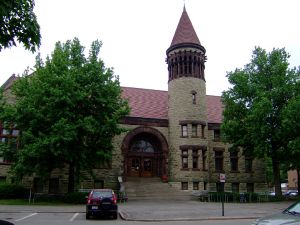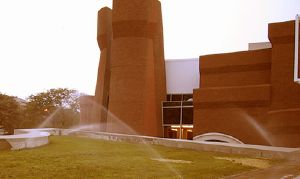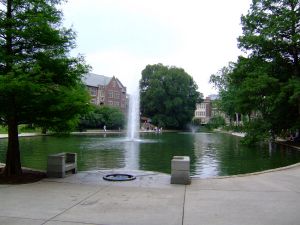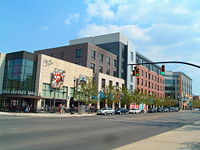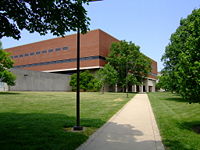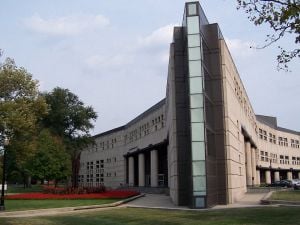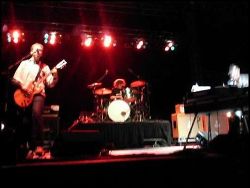Difference between revisions of "Ohio State University" - New World Encyclopedia
Nick Perez (talk | contribs) |
Nick Perez (talk | contribs) |
||
| Line 164: | Line 164: | ||
{{main|List of Ohio State University people}} | {{main|List of Ohio State University people}} | ||
| − | + | *[[Paul Flory]], 1974 [[Nobel Prize|Nobel]] [[Nobel laureate|laureate]] in [[Nobel Prize in Chemistry|Chemistry]] (Ph.D. 1934) | |
| − | + | *[[William A. Fowler]], 1983 Nobel laureate in [[Nobel Prize in Physics|Physics]] (B.S. 1933) | |
| − | + | *'''Milton Arthur Paul Caniff''' ([[February 28]], [[1907]]-[[April 3]], [[1988]]) was an [[United States|American]] [[cartoonist]] famous for the ''[[Terry and the Pirates (comic strip)|Terry and the Pirates]]'' and ''[[Steve Canyon]]'' comic strips. | |
| − | + | *''Kermit Houston Hunter''' ([[3 October]], [[1910]]-[[11 April]] [[2001]]) [[United States|American]] [[playwright]] known primarily for writing [[outdoor drama|outdoor historical dramas]] | |
| − | + | *Daniel G. Amstutz (1932-2006) was a U.S. government official and grain-trading industry executive who played a prominent role in the negotiation of the Uruguay RoundGeneral Agreement on Tariffs and Trade rules on agriculture and the U.S. occupation of Iraq. | |
| + | *William “Mil” Batten, former CEO of J.C. Penney(1958–1974), former President of The New York Stock Exchange(1976–1984) (B.S. 1932) | ||
| + | * Max Martin Fisher, J.D., (July 15, 1908-March 3, 2005) was an internationally-known businessman, philanthropist, and benefactor/alumnus of the Fisher College of Business at Ohio State University | ||
| + | *Ruby Elzy (February 20, 1908–June 26, 1943), was a pioneer African American operatic soprano who created the role of Serena in George Gershwin's folk opera Porgy and Bess and performed in it more than eight hundred times. | ||
| + | *Roberto Sánchez Vilella (February 19, 1913-March 24, 1997) was the second Governor of the Commonwealth of Puerto Rico | ||
| + | *John W. Bricker, Three-term Governor of Ohio, Republican Vice-Presidential nominee in 1944, Two-term United States Senator from Ohio, Co-founder of Bricker & Eckler law firm (B.A. 1916; J.D. 1920), known for the Bricker Amendment, which limits U.S. presidents to two consecutive terms of office | ||
| + | *Jesse L. Brown, First African American Navy pilot, received Navy Distinguished Flying Cross | ||
| + | *Curtis LeMay, United States Air Force general (World War II and Cold War) (B.S. 1928) | ||
| + | *Homer Burton Adkins, organic chemist who developed the Adkins catalyst (Ph.D. 1918) | ||
| + | *Agnes Meyer Driscoll, Cryptanalyst deciphered Japanese Naval Codes before and during World War II (B.A. 1911 | ||
| + | *Charles Kettering, Electrical Engineer, Founder of Delphi Auto Parts, Vice -President of Research for General Motors, invented electric starter for automobiles, Co-founder (along with Alfred Sloan) of Sloan-Kettering Cancer Center in 1945 (B.S. 1904) | ||
| + | *Ruth Ella Moore, Scientist, first African American woman to receive a doctorate degree in bacteriology (B.S. 1926, M.A. 1927, Ph.D. 1933) | ||
| + | *Miller Anderson, Diving 1948 Summer Olympics Silver Medal; 1952 Helsinki Olympic Games Silver Medal | ||
| + | *Jack George, Swimming 1952 Helsinki Olympic Games Bronze Medal | ||
| + | *Jesse Owens, Track and Field 1936 Berlin Olympic Games Four Gold Medals | ||
| + | *Paul Brown, famous coach, member of the Pro Football Hall of Fame, and namesake of Paul Brown Stadium (M.A. 1940) | ||
| + | *Les Horvath, Heisman Trophy winner 1943. | ||
==Notes== | ==Notes== | ||
Revision as of 23:17, 13 December 2008
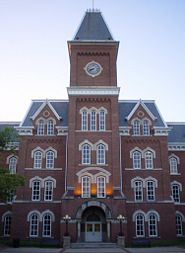
| |
| Motto | Disciplina in civitatem (Latin) Education for Citizenship |
|---|---|
| Established | 1870 |
| Type | Flagship Public Land grant Sea grant |
| Location | Columbus, Ohio United States |
| Website | www.osu.edu |
The Ohio State University (OSU) is a public research university in the state of Ohio. The university was founded in 1870 as a land-grant university and is consistently one of the largest universities in the United States.[1] Offering all levels of higher education programs of study, numerous research institutions, and facilities across the United States, as well as several satellite campuses throughout the state, OSU is a national and international respected school.
Mission and reputation
Ohio State University states its mission statement as simply "To advance the well-being of the people of Ohio and the global community through the creation and dissemination of knowledge."[2] In order to achieve this goal, the University goes on to state that it places emphasis upon the pursuit of knowledge and research, community service, global outreach and diversity within its student body.[3]
OSU has a long standing reputation in excellence. In 2007, the Lombardi Program on Measuring University Performance at Arizona State University detailed analysis and rankings of American universities placed Ohio State as the 24th ranked university in America, the 10th ranked public university in America and the top overall university in Ohio. Of their nine ranking criteria, Ohio State ranked in the top-25 in four categories and between 26-50 in an additional four categories.[4] The Washington Monthly college rankings which seek to evaluate colleges' contributions to American society based on factors of social mobility, cutting edge research and service to the country by their graduates currently places Ohio State as 12th in the nation and 10th among public universities.[5] In its 2009 ranking of best schools in America, the U.S. News & World Report placed Ohio State as the 19th best public university and 56th overall ranked university in America as well as the highest ranked public university in Ohio.[6] Ohio State ranked 14th in US News' New "Up and Coming" colleges section.
History
The Ohio State University was founded in 1870 as a land-grant university in accordance with the Morrill Act of 1862 under the name of the Ohio Agricultural and Mechanical College.[7] The school was originally situated within a farming community located on the northern edge of Columbus. While some interests in the state had hoped that the new university would focus on matriculating students of various agricultural and mechanical disciplines, Governor Rutherford B. Hayes foresaw a more classic, comprehensive university and manipulated both the university's location and its initial board of trustees towards that end; in 1878 the college permanently changed its name to the now-familiar "The Ohio State University", reflecting its expanding role beyond agricultural education[8]. The first students were admitted in 1873, and the first graduation held five years later.[9] In 1906, Ohio State's status as the state's flagship campus was written into law by the Ohio legislature through the Eagleson Bill. In 1916, Ohio State was elected into membership in the Association of American Universities.
Expansion of the university continued exponentially throughout the twentieth century. Between 1957 and 1971, 4 satellite campuses (Marion, Newark, Mansfield and Lima) were opened, all speciality schools designated to teach in areas of technology and agriculture.[10]
Ohio State was the first university in Ohio to be extended membership into the Association of American Universities in 1916 and remains the only public university in Ohio among the organization's sixty members. The Public Ivies: America's Flagship Public Universities (2000) by Howard and Matthew Greene listed Ohio State as one of a select number of public universities offering the highest educational quality.
Ohio State was among the first group[11] of public universities to raise a billion dollar endowment when it passed the one billion dollar mark in 1999. At year’s end 2005, Ohio State’s endowment stood at 1.73 billion dollars ranking it seventh among public universities and twenty-seventh among all American universities.[12] In June 2006, the endowment passed the 2 billion dollar mark.
In recent decades, and in response to continually shrinking state funding, Ohio State has conducted two significant multi-year fundraising campaigns. The first concluded in 1987 and raised 460 million dollars—a record at the time for a public university. The “Affirm Thy Friendship Campaign” took place between 1995 and 2000. With an initial goal of raising 850 million dollars, the campaign’s final tally was 1.23 billion dollars, placing Ohio State among the small group of public universities to have successfully conducted a billion dollar campaign [13].At his welcoming ceremony new President E. Gordon Gee announced that, in the Fall of 2007, Ohio State would be launching a 2.5 billion dollar fundraising campaign.
Facilities
Ohio State's main urban campus, located in Columbus, is over 1,700 acres in size, and offers large green areas as well as the feel and cosmopolitan atmopshere of a metropolitan area. The Oval, one of the largest open areas on campus, located in the center of university's most developed areas, is a hang out for students in the warmer months of the school year. This 11 acre site is often the location for large outdoor gatherings, concerts, demonstrations, and various pick-up sporting events.
The sheer physical size, along with its incredibly large student population, of the campus means there are numerous facilities for students and faculty a like. Overall, Ohio State operates the 18th largest university research library in North America with a combined collection of over 5.8 million volumes. Additionally, the libraries receive approximately 35,000 serial titles on a regular basis. Ohio State's library system encompasses twenty-one libraries located on its Columbus campus.[14] An additional eight branches are located at off-campus research facilities, regional campuses, and a book storage depository near campus. In all the Ohio State library system encompasses fifty-five branches and specialty collections. Some of the more significant collections include The Byrd Polar Research Center Archival Program containing the Archives of Admiral Richard E. Byrd as well as a significant collection of polar research materials, The Hilandar Research Library which contains the world's largest collection of medieval Slavic manuscripts on microform, The Ohio State Cartoon Research Library, which is the world's largest repository of original cartoons, The Lawrence and Lee Theatre Research Institute and the archives of Senator John Glenn.
At the eastern end of The Oval, is the Wexner Center for the Arts. Designed by architects Peter Eisenman of New York and Richard Trott of Columbus, the center opened in 1989. Its founding was financed in large part by Ohio State alumnus Leslie Wexner with a gift of twenty-five million dollars in the 1980s. The center was founded to be a comprehensive visual arts center encompassing all aspects of visual and performing arts with a focus on new commissions and artist residencies. The centerpiece of The Wexner Center's permanent collection is Picasso's Nude on a Black Armchair.[15] OSU has several other museums on campus, including the Frank W. Hale Jr. Black Cultural Center, Historic Costume and Textiles Collection, Jack Nicklaus Museum, and Orton Geological Museum. The university also hosts a 60 acre arboretum named after Ohio State Horticulture professor Dr. Lewis C. Chadwick.[16]
OSU has many athletic facilities to host not only its many sports teams, but also for student wellness and fitness. Among 17 athletic arenas, Ohio Stadium is perhaps the best known. Home of the Buckeyes football team, the stadium is one of the largest college football stadiums in the U.S.[17] OSU has also has other facilities for training and performance in basketball, hockey, soccer, crew, golf and other sports. OSU has two main student physical activity centers: the Recreational Adventure Center and Recreational and Physical Activity Center. Additionally, there is also the Student Wellness Center devoted to promoting healthy lifetsytes to OSU students and faculty.
The Ohio State College of Medicine is located on the southern edge of the central campus. It is home to the James Cancer Hospital, a cancer research institute and one of the National Cancer Institutes thirty-nine comprehensive cancer centers, along with the Richard M. Ross Heart Hospital, a research institute for cardiovascular disease.
The university also operates several regional campuses and research facilities at:
- The Ohio State University, Agricultural Technical Institute
- The Ohio State University, Lima Campus
- The Ohio State University, Mansfield Campus
- The Ohio State University, Marion Campus
- The Ohio State University, Newark Campus
- The Ohio State University, Cortland Campus
Ohio State operates 31 on-campus residence halls divided into three geographic clusters: South Campus (site of the university's original dormitories), North Campus (largely constructed during the post-war enrollment boom) and Olentangy Area or "The Towers." Within the residence hall system are 40 smaller living and learning environments defined by social or academic considerations. Ohio State also offers four honors residence halls: Bradley Hall, Lincoln House, Siebert Hall, and Taylor Tower.
Separate housing for graduate and professional students is maintained on the Southern tier of campus near the medical complex. Family housing is maintained at Buckeye Village at the far northern edge of campus beyond the athletic complex. At the university's southeast corner along High Street, and across from the Moritz College of Law, new apartments have been built for law students in conjunction with the area's Campus Gateway project.
Programs
A unique aspect to Ohio State's multi billion dollar endowment is the Student Investment Management Program. Upperclass finance students taking Business Finance 724 are given the opportunity to manage a twenty million dollar investment fund. Returns from the student managed funds often outperform the S&P 500 and frequently even the university's own professional fund managers.[18]
US News ranks the undergraduate program at Ohio State's Fisher College of Business 12th in America and the top undergraduate business school in Ohio. The graduate program of the Fisher College is ranked 22nd in America and the top graduate school of business in Ohio. The Economist ranked The Fisher College as the 29th ranked MBA program in the world in their 2005 "Which MBA?" issue.[19] In 2006, The Public Accounting Report ranked Ohio State's accounting department 9th in the nation for undergraduate programs and 10th in the nation for graduate programs. In each case, the ranking was the highest among Ohio universities.[20] The Ohio State law school is ranked by US News as the top law school in Ohio and 31st overall in America. Ohio State's medical school is ranked as the top public medical school in Ohio and 31st for research and 38th for primary care. US News ranks Ohio State's undergraduate engineering program as the 25th best program in America and the top undergraduate engineering program in Ohio. Its graduate program in engineering is ranked 26th in the country and highest in Ohio. Ohio State's College of Education was ranked 17th in America by US News and the highest in Ohio. The Counseling/Personnel Services graduate program at Ohio State is ranked 4th in America by the 2008 'US News & World Report'. In total, US News & World Report ranked 19 Ohio State graduate programs or specialties among the nation's top ten and 30 among the nation's top 25.[21]
Ohio State's political science department is ranked thirteenth in the country by US News & World Report, with the American politics section 5th, international politics 12th and political methodology 10th. A study by The London School of Economics ranked it as the fourth best political science department in the world.[22] Foreign Policy Magazine recently ranked it as the 15th best Ph.D. program in the world for the study of international relations while noting Professor Alexander Wendt as the third most influential scholar of international relations in the world.[23]
Ohio State is one of a select few top American universities to offer multiple area studies programs under "Comprehensive National Resource Center" (often called "Title VI") funding from the U.S. Department of Education. The most notable of these is the Center for Slavic and East European Studies founded in 1965 by Professor Leon Twarog. Subsequently, Ohio State's Middle Eastern Studies Center and East Asian Studies Center also achieved Comprehensive National Resource Center status. The university is also home to the interdisciplinary Mershon Center for International Security Studies, which was founded in 1952 through a bequest of 7 million dollars (54.3 million in 2006 value) from alumnus Colonel Ralph D. Mershon. In 2003, it was decided by the United States Department of Homeland Security to base the National Academic Consortium for Homeland Security at The Mershon Center.
In a study by industry publication Dance Teacher, a survey of 100 dance department chairs in the United States and Canada ranked Ohio State's Department of Dance as the top ranked graduate program and the second ranked undergraduate program in North America.
U.S. News & World Report ranked the graduate program in Design at #5 in the nation in their 2009 rankings. Overall, the graduate Art program ranked #21, with the ceramics and glass programs at #6[24]. In 2008, DesignIntelligence, an industry newsletter sponsored by the Design Futures Council, ranked the undergraduate Industrial Design program #3 nationwide, and the graduate program in Design #10 nationwide. Ohio State trails number-one ranked Art Center College of Design (Pasadena) and the University of Cincinnati. The DFC conducted their research by polling 270 corporations regarding how design schools were preparing their students for the future of professional practice in design. OSU was in the top ten rankings of the corporate leaders' assessments in all regions (#4 in the south, #2 in the midwest, #7 in the east, and #4 in the west). The graduate program placed at #3 in the south and #2 in the east, resulting in 10th overall in the nation.[25]
Honors programs
Ohio State offers two distinct honors programs for high ability undergraduates: Honors and Scholars. The Honors program is open to students in all majors. The Scholars program is centered around thirteen specific programs such as "Architecture Scholars", "Communication Technology Scholars","Biological Sciences Scholars", "International Affairs Scholars" and "Politics, Society and Law Scholars." Students in the Scholars program are expected to live and take select classes with other members of the program. Additionally, Ohio State offers the Honors Collegium with membership extended following the Spring of a student's first or second year to the university's top undergraduates. Collegium students try to compete for internships, graduate schools and nationally competitive awards, such as the Marshall, Rhodes, or Truman Scholarships.
Colleges/Departments/Institutes
The Ohio State University comprises the following colleges and schools:
- Ohio State University College of Dentistry
- College of Education and Human Ecology
- College of Engineering
- Austin E. Knowlton School of Architecture
- College of Food, Agricultural, and Environmental Sciences
- School of Environment and Natural Resources
- College of Medicine
- College of Nursing
- College of Optometry
- College of Pharmacy
- College of Public Health
- College of Social Work
- College of Veterinary Medicine
- Colleges of the Arts and Sciences
- School of Communication
- School of Music
- Graduate School
- John Glenn School of Public Affairs
- Max M. Fisher College of Business
- Michael E. Moritz College of Law
OSU also has several research facilities and centers located around the U.S.:
- "Byrd Polar Research Center" - Facility for Polar and Alpine research.
- "Biological Research Tower" - Facility designed to create and study new systems of personalized healthcare.
- "Large Binocular Telescope" (LBT, originally named the Columbus Project) - When completed, it will be the world's highest resolution and most technologically advanced optical telescope[26]
- "Mershon Center for International Security Studies"
- "Stone Laboratory|Stone Laboratory on Gibraltar Island, OH" - Facility shared by Great Lakes Aquatic Ecosystem Research Consortium.
- "Ohio Agricultural Research and Development Center|The Ohio State University, Ohio Agricultural Research and Development Center" - Devoted to the research of foods, agriculture, family and the environment.
Student life
With student population of over 50,000 people, OSU offers its student's an environment rich in experience and possibilities beyond education. Ohio State's main campus has been lauded in recent years for the diversity of its student body. In various surveys and rankings it has been included among the best campuses in the nation for African Americans,[27] as well as for Hispanics and gays and lesbians.[28] The Office of Student Life is responsible for many of the outside-the-classroom aspects of student life at Ohio State. Among these are student housing; food service; health, wellness and counseling; activities, organizations and leadership development; recreation and intramurals.
Student organizations at The Ohio State University provide students with opportunities to get involved in a wide variety of interest areas including academic, social, religious, artistic, service-based, diversity and many more. There are over 800 registered student organizations that involve many thousands of students. Some examples of programs to get involved in are the Residence Halls Advisory Council, Buckeye Leadership Society, LeaderShape, Buckeye Service Council, Community Commitment, and Alternative Spring Break.
At the Ohio State University, there are three recognized student governments that represent their constituents.
- Undergraduate Student Government (USG), which consists of elected and appointed student representatives who serve as liaisons from the undergraduate student body to university officials.
- Council of Graduate Students (CGS), which promotes and provides academic, administrative, and social programs for the university community in general and for graduate students in particular.
- Inter-Professional Council (IPC), which is a representative body of all professional students in the colleges of Dentistry, Law, Medicine, Optometry, Pharmacy, and Veterinary Medicine.
Ohio State has several student managed publications and media outlets: The Makio is the official yearbook of The Ohio State University and is operated by students, for students. The Makio, was started by three fraternities in 1880. The Lantern is the school's daily newspaper and has operated as a laboratory newspaper in the School of Communication (formerly the School of Journalism) since 1881. Mosaic is a literary magazine published by Ohio State, which features undergraduate fiction, poetry, and art. OHIO.FM is the student-run radio station with an Internet audio stream (no broadcast signals are available in Columbus). Students also operate a local cable channel known as Buckeye TV, which airs primarily on thecampus cable system operated by the Office of Information Technology (OIT).
Ohio State's intercollegiate sports teams are called the "Buckeyes" (after the state tree, the Buckeye), and participate in the NCAA's Division I in all sports (Division I FBS in football) and the Big Ten Conference in most sports. (The men's hockey program competes in the Central Collegiate Hockey Association, and its women's hockey program competes in the Western Collegiate Hockey Association). The school colors are Scarlet and Gray. The teams' nickname is "Buckeyes" and "Brutus" the Buckeye is their mascot. Ohio State is one of only three universities (the University of Michigan and the University of California at Berkeley being the others) to have won national championships in baseball, men's basketball, and football.[29] Ohio State is also one of two of the only universities to appear in national championship games in football and men's basketball in the same calendar year (2007) (the University of Florida being the other, vs. Ohio State in 2007.). Ohio State has also won national championships in men's swimming & diving, men's outdoor track & field, men's golf, men's gymnastics, men's fencing, co-ed fencing, and multiple synchronized swimming championships.[30]
Traditions
The Ohio State University Marching Band (or TBDBITL, "The Best Damn Band in the Land") is a longstanding tradition at Ohio State. The marching band is the largest all-brass and percussion band in the world. The traditional school songs from "Carmen Ohio" to "Hang on Sloopy" to "Fight the Team Across the Field", are arranged to fit this unique instrumentation. The band is famous for "Script Ohio," during which the band marches single-file through the curves of the word "Ohio", much like a pen writes the word, all the while playing the French march "Le Regiment de Sambre et Meuse." At the end of the performance, the "i" in "Ohio" is "dotted" by a high-stepping senior sousaphone player.
Notable among a number of songs commonly played and sung at various events such as commencement and convocation, and athletic games are: Across the Field, the Ohio State University fight song and "Buckeye Battle Cry".
The tradition of high quality bands is not limited to the football field. OSU's School of Music contains several high quality concert bands consisting of graduate and undergraduate music majors and non-music majors. The OSU Wind Symphony, frequently receives praise on the national level, recently having been selected to perform at the 2003 and 2008 College Band Directors National Association (CBDNA) Convention, with the Symphonic Band performing in 2007. The Wind Symphony has recently released its newest album "Jubilare!" released on the Naxos Label. The Ohio State Jazz Ensemble performed at the Montreux Jazz Festival in 1975, 1978,1986, 1996, and 2001. It has also appeared at the Mexico City International Jazz Festival in 1990 and the North Sea Jazz Festival in 1986, 1996, and 2001.
In addition to strong bands, the university is also recognized for outstanding choral performance. The Ohio State Men's Glee Club, formed in 1875, is the oldest organization on campus.[31] In 1990, led by Professor James Gallagher, the Men's Glee Club participated in the International Musical Eisteddfod in Llangolen, Wales and won the male chorus competition by an unprecedented 20 points before, in a unanimous decision of the judges, being named "Choir of the World"—the first American choir to win such an honor. The Glee Club is under the direction of Dr. Robert J. Ward.
Notable alumni
- Paul Flory, 1974 Nobel laureate in Chemistry (Ph.D. 1934)
- William A. Fowler, 1983 Nobel laureate in Physics (B.S. 1933)
- Milton Arthur Paul Caniff (February 28, 1907-April 3, 1988) was an American cartoonist famous for the Terry and the Pirates and Steve Canyon comic strips.
- Kermit Houston Hunter' (3 October, 1910-11 April 2001) American playwright known primarily for writing outdoor historical dramas
- Daniel G. Amstutz (1932-2006) was a U.S. government official and grain-trading industry executive who played a prominent role in the negotiation of the Uruguay RoundGeneral Agreement on Tariffs and Trade rules on agriculture and the U.S. occupation of Iraq.
- William “Mil” Batten, former CEO of J.C. Penney(1958–1974), former President of The New York Stock Exchange(1976–1984) (B.S. 1932)
- Max Martin Fisher, J.D., (July 15, 1908-March 3, 2005) was an internationally-known businessman, philanthropist, and benefactor/alumnus of the Fisher College of Business at Ohio State University
- Ruby Elzy (February 20, 1908–June 26, 1943), was a pioneer African American operatic soprano who created the role of Serena in George Gershwin's folk opera Porgy and Bess and performed in it more than eight hundred times.
- Roberto Sánchez Vilella (February 19, 1913-March 24, 1997) was the second Governor of the Commonwealth of Puerto Rico
- John W. Bricker, Three-term Governor of Ohio, Republican Vice-Presidential nominee in 1944, Two-term United States Senator from Ohio, Co-founder of Bricker & Eckler law firm (B.A. 1916; J.D. 1920), known for the Bricker Amendment, which limits U.S. presidents to two consecutive terms of office
- Jesse L. Brown, First African American Navy pilot, received Navy Distinguished Flying Cross
- Curtis LeMay, United States Air Force general (World War II and Cold War) (B.S. 1928)
- Homer Burton Adkins, organic chemist who developed the Adkins catalyst (Ph.D. 1918)
- Agnes Meyer Driscoll, Cryptanalyst deciphered Japanese Naval Codes before and during World War II (B.A. 1911
- Charles Kettering, Electrical Engineer, Founder of Delphi Auto Parts, Vice -President of Research for General Motors, invented electric starter for automobiles, Co-founder (along with Alfred Sloan) of Sloan-Kettering Cancer Center in 1945 (B.S. 1904)
- Ruth Ella Moore, Scientist, first African American woman to receive a doctorate degree in bacteriology (B.S. 1926, M.A. 1927, Ph.D. 1933)
- Miller Anderson, Diving 1948 Summer Olympics Silver Medal; 1952 Helsinki Olympic Games Silver Medal
- Jack George, Swimming 1952 Helsinki Olympic Games Bronze Medal
- Jesse Owens, Track and Field 1936 Berlin Olympic Games Four Gold Medals
- Paul Brown, famous coach, member of the Pro Football Hall of Fame, and namesake of Paul Brown Stadium (M.A. 1940)
- Les Horvath, Heisman Trophy winner 1943.
Notes
- ↑ "Ohio State named nation’s largest college – again", Dayton Business Journal, 2008-10-20. Retrieved 2008-12-09.
- ↑ (2008)Ohio State University"The Ohio State University Vision" Retrieved December 9, 2008
- ↑ (2008)Ohio State University"The Ohio State University Vision" Retrieved December 9, 2008
- ↑ (2007) Lombardi, John, Capadli, Elizabeth and Craig Abbey "The Lombardi Program, 2007 Ranking of Top American Universities" Retrieved December 9, 2008.
- ↑ (2007) Ohio State University "Ohio State news release on 2007 rankings" Retrieved December 9, 2008
- ↑ (2008) 'U.S. News & World Report "Best Colleges: Ohio State" Retrieved December 9, 2008
- ↑ hio State University. (2008). In Encyclopædia Britannica. Retrieved December 9, 2008, from Encyclopædia Britannica Online: http://www.search.eb.com/eb/article-9002059
- ↑ The Ohio State University Timeline 1870 TO 1899, The Ohio State University Archives
- ↑ (2008) Ohio State University "News Room: The Ohio State History and Traditions" Retrieved December 9, 2008
- ↑ hio State University. (2008). In Encyclopædia Britannica. Retrieved December 9, 2008, from Encyclopædia Britannica Online: http://www.search.eb.com/eb/article-9002059
- ↑ OHIO STATE ENDOWMENT TOPS $1 BILLION 2-5-99, Ohio State News
- ↑ 2005 University Endowments.
- ↑ Top 15 Public University Endowments as of June 30, 2004
- ↑ (2008) Ohio State University "About the Libraries" Retrieved December 11, 2008
- ↑ (2008) Wexner Center for the Arts "About Us" Retrieved December 11, 2008
- ↑ (2008) Ohio State University "Visitors: Gradens and Plazas" Retrieved December 11, 2008
- ↑ (2008) Ohio State University "Ohio State Football" Retrieved December 13, 2008
- ↑ Ohio State Student Investment Management Program.
- ↑ The Economist: Which MBA.
- ↑ Public Accounting Report 2006 Rankings.
- ↑ Ohio State "By The Numbers".
- ↑ London School of Economics Study.
- ↑ Foreign Policy: Inside The Ivory Tower November/December 2005.
- ↑ OSU Press Release, 3-31-2008
- ↑ DesignIntelligence, America's Best Architecture & Design Schools, 2008.
- ↑ (2008) Large Binocular Telescope Observatory "Welcome" Retrieved December 13, 2008
- ↑ Donaldson, Sonya A. "50 Best colleges for African Americans: the right college environment can make or break an experience. Here's how to make sure students choose the school that's best for them. (Special Report)." Black Enterprise, January 1, 2003 [1] Retrieved December 13, 2008
- ↑ Rosenbloom, Stephanie.Is This Campus Gay-Friendly? NY Times September 14, 2006.[2] Retrieved December 13, 2008
- ↑ (2007) NCAA Championships "NCAA National Championship Database" Retrieved December 13, 2008
- ↑ (2007) NCAA Championships "NCAA National Championship Database" Retrieved December 13, 2008
- ↑ OSU Men's Glee Club
ReferencesISBN links support NWE through referral fees
- Kinnison, William A. (1970). Building Sullivant's Pyramid; An Administrative History of The Ohio State University, 1870-1907. Columbus, OH: Ohio State University Press. ISBN 0-8142-0141-5.
- The Ohio State University Mirror Lake Hollow (1984) by John H. Herrick, Executive Director Emeritus, Campus Planning
- The Ohio State University Oval (1982) by John H. Herrick, Executive Director Emeritus, Campus Planning
- Baroway, Malcolm S. (2003). The Gee Years, 1990-1997. Columbus, OH: Ohio State University Press. ISBN 0-8142-0918-1.
- Perry, Chris (2005). The Kirwan Years: 1998-2002. Columbus, OH: Ohio State University Press. ISBN 0-8142-1027-9.
- The Ohio State University Oral History Project
- Interactive Historical Map of The Ohio State University Campus
- John H. Herrick Archives at the Knowlton School of Architecture
- History of The Ohio State University from the Ohio State University Archives
External links
| Association of American Universities | |
|---|---|
| Public | Arizona • Buffalo (SUNY) • UC Berkeley • UC Davis • UC Irvine • UCLA • UC San Diego • UC Santa Barbara • Colorado • Florida • Illinois • Indiana • Iowa • Iowa State • Kansas • Maryland • Michigan • Michigan State • Minnesota • Missouri • Nebraska • North Carolina • Ohio State • Oregon • Penn State • Pittsburgh • Purdue • Rutgers • Stony Brook (SUNY) • Texas • Texas A&M • Virginia • Washington • Wisconsin |
| Private | |
| Canadian | McGill • Toronto |
Credits
New World Encyclopedia writers and editors rewrote and completed the Wikipedia article in accordance with New World Encyclopedia standards. This article abides by terms of the Creative Commons CC-by-sa 3.0 License (CC-by-sa), which may be used and disseminated with proper attribution. Credit is due under the terms of this license that can reference both the New World Encyclopedia contributors and the selfless volunteer contributors of the Wikimedia Foundation. To cite this article click here for a list of acceptable citing formats.The history of earlier contributions by wikipedians is accessible to researchers here:
The history of this article since it was imported to New World Encyclopedia:
Note: Some restrictions may apply to use of individual images which are separately licensed.

